[Ten years since the Great East Japan Earthquake Vol. 1] Minimizing cyclone damage in Mozambique: Drawing on the experience of the earthquake to build a disaster-resilient society
2021.03.09
In response to natural disasters, which can occur at any time and in any place, JICA has continued to work tirelessly in developing countries, from providing emergency assistance immediately after disasters to cooperation for “Build Back Better” in disaster-stricken areas. The lessons learned from the Great East Japan Earthquake are being utilized in these efforts.
As we mark the 10th anniversary of the great earthquake that struck eastern Japan, we will introduce JICA's cooperation for recovery and reconstruction, disaster risk reduction, and disaster mitigation in developing countries in a three-part series. In this first issue, we will start with Mozambique, a country in southeastern Africa that aims to build a disaster-resilient society through its ties with the Tohoku region in northeast Japan.
At the end of last year, a cyclone hit Mozambique. However, thanks to an evacuation plan prepared in collaboration between residents and the local government, people were able to evacuate quickly, and minimal damage occurred. The evacuation plan was developed using hazard maps based on data from past cyclones, and it took into account the views of residents. This process reflects the sincere voices of those from the areas affected by the Great East Japan Earthquake.
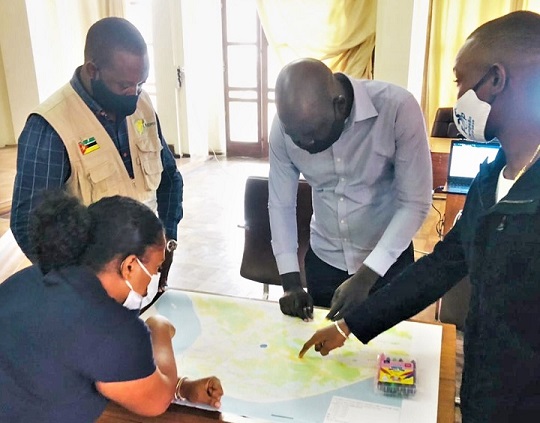
Disaster risk reduction officials of the city of Beira, Mozambique, discuss the evacuation plan based on the hazard map. Advance preparation for disaster risk reduction and mitigation is critical in building a disaster-resilient society
“In the case of Cyclone Idai, confusion arose because we didn't know what actions to take beforehand. However, when Cyclone Chalane struck, we were able to evacuate the city smoothly in advance and minimize the damage,” explains Daviz Mbepo Simango, mayor of Beira city, Mozambique.
Cyclone Idai, which struck Beira in March 2019, caused massive devastation, with 650 deaths and 400,000 internally displaced people. Based on this experience, JICA has been engaged in a project to build disaster-resilient communities in Beira since September 2019.

A scene during Cyclone Idai in March 2019 (left)
Evacuation plans were not yet in place, and residents were stranded along roads that were cut off by heavy rains (right)
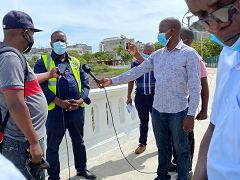
The mayor of Beira urging residents to evacuate at a press conference the day before Chalane made landfall
In the midst of this, Cyclone Chalane struck on December 30, 2020. Using the lessons learned from Cyclone Idai, the city of Beira successfully minimized the damage by calling for evacuation in cooperation with relevant organizations and were able to smoothly direct residents to safe facilities in advance.
JICA Senior Advisor HIRABAYASHI Atsutoshi describes the achievements of the ongoing project as follows. “In the recovery and reconstruction support in Mozambique, we are striving to work with a greater sense of speed based on our past experiences. During Cyclone Chalane and also during Cyclone Eloise immediately after that on January 23 this year, the local government used the hazard maps developed earlier in the project. The implementation of the evacuation plan created by the residents and the local government helped keep human casualties to a minimum.”
The key to building disaster-resilient communities lies in how well everyone is prepared for disaster risk reduction and mitigation during normal times. In this project, leaders from countries that are working on recovery and reconstruction, disaster risk reduction, and mitigation, such as Francisco Pereira, executive director of the Post Cyclone Idai Reconstruction Cabinet, and directors of national disaster management agencies, were invited to Japan to visit the areas affected by the Great East Japan Earthquake. They exchanged opinions with those involved, and listened to the voices of those who experienced the disaster.
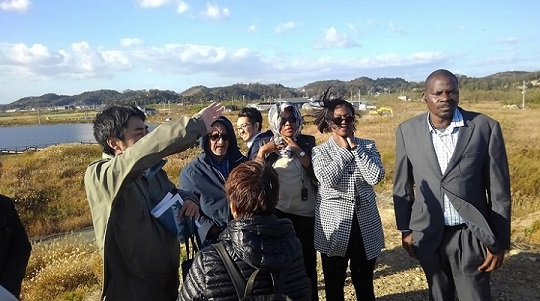
KAWAGUCHI Takafumi (left), chief administrator of Reconstruction Policy Division of Higashi-Matsushima city, explains the situation at the time during a training program with the Mozambique Reconstruction Agency executive director and others
Mr. Hirabayashi, who accompanied the training participants to the disaster-affected areas, recalls that interactions with the disaster victims in Higashi-Matsushima city, in particular, motivated the Mozambican leaders to build a disaster-resilient society.
“The victims in Higashi-Matsushima city said, ‘After 3.11, the whole world reached out to us. Now it is our turn to give back,' and this moved and motivated the Mozambican leaders. In addition, KAWAGUCHI Takafumi, chief administrator of Reconstruction Policy Division of Higashi-Matsushima city, came to Mozambique to share his experience of recovery and reconstruction with the local residents, even though the recovery and reconstruction of his hometown is still underway. He said, ‘You never know when a natural disaster will strike. It is important for both residents and government officials to tackle recovery and reconstruction, and disaster mitigation, as their own matter!’ I think the message from Mr. Kawaguchi resonated well.”
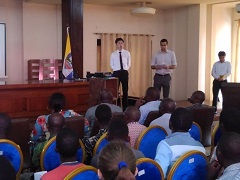
Mr. Kawaguchi (center) in Mozambique speaks about Higashi-Matsushima city’s recovery and reconstruction experience and lessons learned.
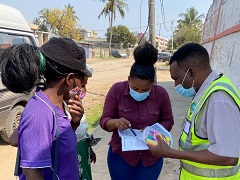
Disaster risk reduction officials from the city of Beira verify evacuation routes
This people of Tohoku’s desire not to let the disaster be forgotten has supported the development of a disaster-resilient society in Mozambique. It led to disaster risk reduction and mitigation efforts based on the actual conditions, such as the understanding and use of hazard maps and the creation and implementation of evacuation plans by residents and local governments.
Mr. Hirabayashi, who is unable to travel to Mozambique due to the COVID-19 pandemic, is currently continuing to collaborate remotely with the project team. While struggling with unreliable communications, the team has been working online with local government officials, consultants, and contractors using drones and 360-degree cameras to carry out construction work in the affected areas.
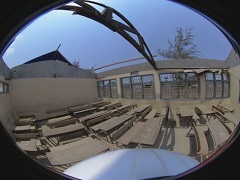
A view of the construction site of an elementary school, which is about to be built. 360-degree camera images are being used to provide remote support from Japan
The project team is committed and working closely with the local people to apply Japanese knowledge based on the experience of the Great East Japan Earthquake. Mr. Hirabayashi strongly emphasizes the significance of a careful process in which residents and local governments work together for recovery and reconstruction as well as disaster risk reduction and mitigation, in other words, “strengthening the soft side as well as the hard side.”
“While maintaining a sense of urgency, it is crucial to proceed with consensus-building through careful dialogue with the victims to achieve a better recovery. In Japan, after the Great East Japan Earthquake, the importance of the basic concept of ‘consensus building between residents and local governments in the recovery and reconstruction process’ has been reinforced, but this is still not widely recognized in developing countries. It is vital to plan how to rebuild the community in order to protect lives, and to promote disaster-resilient community development by sharing opinions and wisdom among the affected residents, government officials, and local government employees, all of whom share the same understanding of disaster risks.”
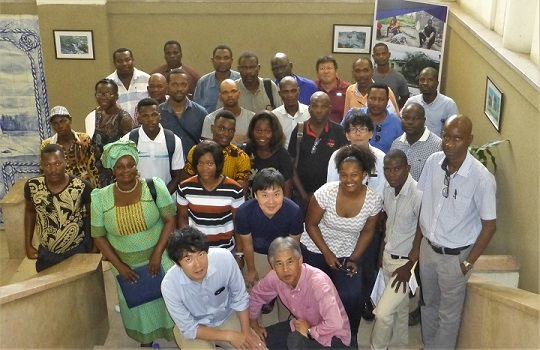
With the help of the project, a disaster risk reduction workshop was held with Beira city officials and district representatives. Recovery and reconstruction knowledge from the Great East Japan Earthquake is also being put to good use in Africa
*As of the time of writing this article, on February 22, we received the news from Beira that Mayor Daviz Mbepo Simango passed away suddenly due to COVID-19. All of us involved in the project are deeply saddened by the sudden news of the death of the mayor, who had been working energetically for the recovery and reconstruction of Beira city since immediately after the Cyclone Idai disaster. In order to repay Mr. Simango's strong determination for the recovery and reconstruction, we will make further efforts to implement the project in Mozambique. Thank you very much, Mayor Simango. We sincerely hope that you will rest in peace.
From all of us involved in the project
scroll